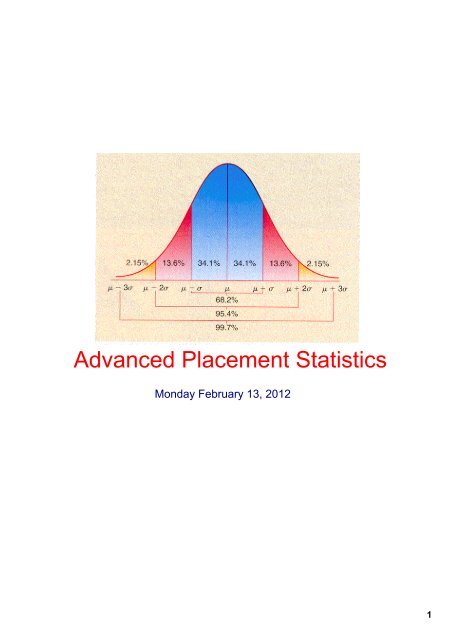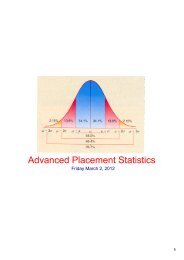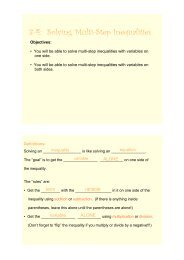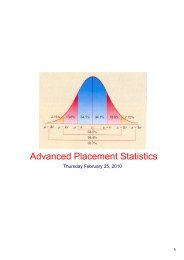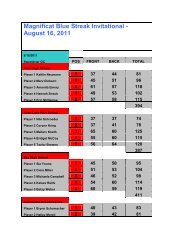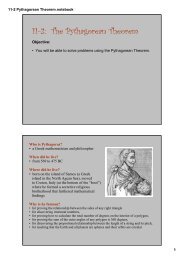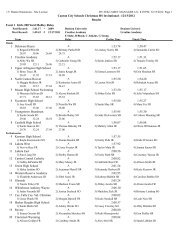February 13
February 13
February 13
You also want an ePaper? Increase the reach of your titles
YUMPU automatically turns print PDFs into web optimized ePapers that Google loves.
Advanced Placement Statistics<br />
Monday <strong>February</strong> <strong>13</strong>, 2012<br />
1
Daily Agenda<br />
1. Welcome to class<br />
2. Please find folder and take<br />
your seat.<br />
3. Review Chapter 10 Section 1 worksheet<br />
4. Introduce Chapter 10 Section 2<br />
5. Practice finding upper critical t values<br />
6. Explain matched pairs inference<br />
7. Collect Folders<br />
2
HOMEWORK REVIEW<br />
3
10.24 Newts and the data distribution<br />
conclusion no outliers, small skew<br />
4
OTL C10#4<br />
P 632: 10.12,<br />
P 637: 10.14, and 10.17<br />
5
10.14 pg 637<br />
To assess the accuracy of a laboratory scale, a standard<br />
weight known to weigh 10 grams is weighed repeatedly.<br />
The scale readings are Normally distributed with unknown<br />
mean (the mean is 10 g if the scale has no bias). The<br />
standard deviation of the scale readings is known to be<br />
0.0002 gram.<br />
a) The weight is weighed five times. The mean result is<br />
10.0023 grams. Construct and interpret a 95% confidence<br />
interval for the mean of repeated measurements of the<br />
weight.<br />
P<br />
μ = the mean of repeated measurements of this standard weight<br />
A<br />
∎ We must assume that the sample is random,<br />
so x is an unbiased estimator of μ.<br />
∎ we are told that our sample is taken from a normal<br />
population, so the shape of the sampling distribution is<br />
approximately normal.<br />
N<br />
∎ 10(5) = 50 and assume 50 < total number of times we could repeatedly<br />
weigh the weight , so is appropriate for the sampling<br />
distribution standard deviation.<br />
Use a z confidence interval for a population mean<br />
I 10.0023 ± 1.96 (0.0002/√5 )<br />
C I am 95% confident that the true mean scale reading for a 10<br />
gram weight is captured by the interval (10.0021, 10.0025)<br />
grams.<br />
8
10.14 pg 637<br />
To assess the accuracy of a laboratory scale, a standard<br />
weight known to weigh 10 grams is weighed repeatedly.<br />
The scale readings are Normally distributed with unknown<br />
mean (the mean is 10 g if the scale has no bias). The<br />
standard deviation of the scale readings is known to be<br />
0.0002 gram.<br />
b) How many measurements must be averaged together<br />
to get a margin of error of ± 0.0001 with 98% confidence?<br />
9
10.17 pg 638<br />
A radio talk show invites listeners to enter a dispute about a<br />
proposed pay increase for city council members. "What<br />
yearly pay do you think council members should get? Call<br />
us with your number." In all, 958 people call. The mean<br />
pay they suggest is x = $8740 per year, and the standard<br />
deviation of the responses is s = $1125. For a large sample<br />
such as this, s is very close to the unknown population σ.<br />
The station calculates the 95% confidence interval for the<br />
mean pay μ that all citizens would propose for council<br />
members to be $8669 to $8811.<br />
a) Is the station's calculation correct ?<br />
b) Does their conclusion describe the population of all the city's citizens?<br />
Explain your answer.<br />
10
OTL C10#5<br />
P 640: 10.19, 10.20 b only<br />
P 641: 10.21, 10.22, 10.25<br />
10.19 a) sentence(s) three conditions<br />
b) just the I part of PANIC<br />
c) sentence (our special one)<br />
10.20 b) only show your arithmetic<br />
10.21 Sentence to answer question.<br />
10.22 Sentence to justify answer.<br />
10.25 Use 10.24 for the numbers.<br />
show your arithmetic<br />
11
CONFIDENCE<br />
INTERVAL<br />
CAUTIONS<br />
!<br />
!<br />
!<br />
Inference must assume SRS<br />
Always round up when finding n<br />
The size of the sample determines<br />
the margin of error NOT the size of<br />
the population<br />
16
CONFIDENCE INTERVAL<br />
CAUTIONS<br />
!<br />
!<br />
Different methods are needed for<br />
different sampling designs<br />
There is no correct method for<br />
inference from BAD data (bias,<br />
poorly collected, no known sample<br />
size)<br />
! Outliers can distort the results<br />
!<br />
!<br />
The shape of the population<br />
distribution matters (condition 2)<br />
FOR z we must know σ<br />
17
The "parent" or original normal curve function.<br />
18
Area under the standard normal curve = 1<br />
19
Let's Get REAL no σ<br />
What happens when we are in the real world and<br />
we don't have any secret messages from above.<br />
We DO NOT know the population standard<br />
deviation σ. SO what do we do?<br />
What to do ???<br />
Use S x instead ----⇒ what are the consequences ?<br />
Obviously more room for error ...<br />
20
Goal Calculate and interpret a confidence Interval<br />
Part 1 - calculate an upper critical t score (t*)<br />
1. Sketch a semi - normal curve (floating), add the<br />
confidence level into the curve<br />
2. Subtract to find the area<br />
outside the confidence level.<br />
3. Add to find the area to the left of<br />
the desired t score (t * ). This is<br />
called the upper critical t score<br />
4. Look up the t score for the given area.<br />
This is a backwards table problem<br />
OR use the t-AREA (add degrees of freedom)<br />
program in your calculator. This is the desired t *<br />
23
Goal Calculate and interpret a confidence Interval<br />
Part 2 - calculate the confidence interval<br />
USE THE PANIC METHOD<br />
P parameter declaration or description<br />
A assumptions (check the assumption)<br />
N name the test that your will use<br />
I interval, calculate the confidence interval (math)<br />
C conclusion, state your conclusion using our sentence<br />
25
MORE DETAIL of PANIC<br />
P μ = the mean of the population<br />
ρ = the population proportion<br />
make this description very specific to the problem<br />
A assumptions (3 to check)<br />
1) SRS must be stated in the problem<br />
2) check for "normality"<br />
a) this can be stated in the problem<br />
b)<br />
**<br />
* Sample size < 15.<br />
NO OUTLIERS, NORMAL POPULATION<br />
* Sample size ≥ 15.<br />
NO OUTLIERS, NO STRONG SKEW<br />
* Large sample size (n > 30)<br />
NO OUTLIERS<br />
if n(p) ≥ 10 and n(p1)≥10<br />
∧<br />
then thumb 2 passes for ρ,p world<br />
c) plot a histogram or boxplot and eyeball<br />
the graph for "normality"<br />
3) 10(n) ≤ total population<br />
(Independence and thumb 1)<br />
(no better method available)<br />
N name the test<br />
t confidence interval for a population mean<br />
with _____ degrees of freedom<br />
I Interval (do the math)<br />
C conclusion<br />
I am ____% confident that the true (mean or<br />
proportion) of the ________ population is<br />
captured by the interval ( , ) units.<br />
make this description very specific to the problem<br />
26
** Using the t proceedures CAUTIONS<br />
* except in the case of small samples, the assumption that<br />
the data are from an SRS is more important than the<br />
assumption that the population distribution is normal<br />
* Sample size < 15.<br />
NO OUTLIERS, NORMAL POPULATION<br />
* Sample size ≥ 15.<br />
NO OUTLIERS, NO STRONG SKEW<br />
* Large sample size (n > 30)<br />
NO OUTLIERS<br />
29
PRACTICE page 648: 10.27, 10.31<br />
10.27 a) find the standard error of the mean<br />
1.789785834<br />
b) 0.84±0.01 and n = 3<br />
SEM = ?<br />
34
10.31 Give it some gas!<br />
35
10.31 Give it some gas!<br />
36
t-curve explanation and exploration<br />
10.37 finding t using a table<br />
37
Matched Paired t Procedures<br />
The parameter μ in paired t procedure is ...<br />
∎ the mean difference in the responses to the two treatments<br />
within matched pairs of subjects in the entire population<br />
∎ the mean difference in response to the two treatments for<br />
individuals in the population (when the same subject<br />
receives both treatments)<br />
∎ the mean difference between before-and-after<br />
measurements for all individuals in the population.<br />
39
Class examples page 657 & 658 10.33, 10.35, 10.36<br />
40
AP STATISTICS HOMEWORK ASSIGNMENT due 2/14/12<br />
page 649: 10.30 list CSB<br />
page 650: 10.32 list AMBER<br />
page 659: 10.39 and 10.40<br />
list HAV<br />
41
What type of plot is this?<br />
How do you analyze this plot?<br />
51


